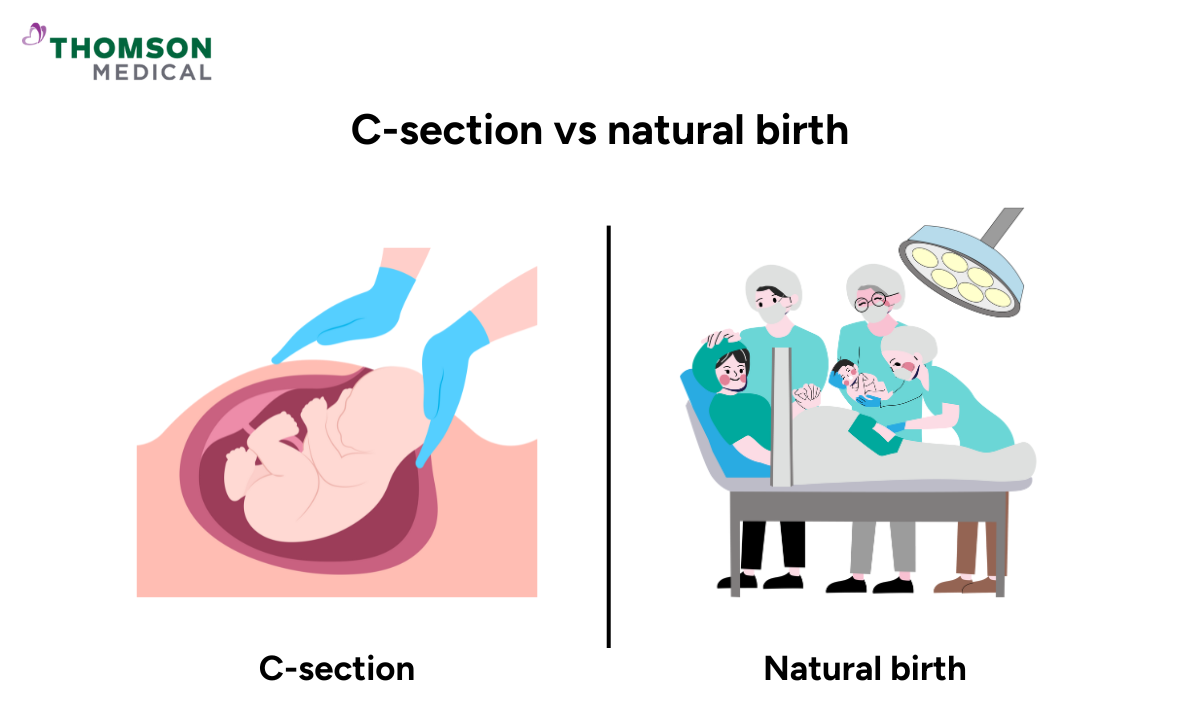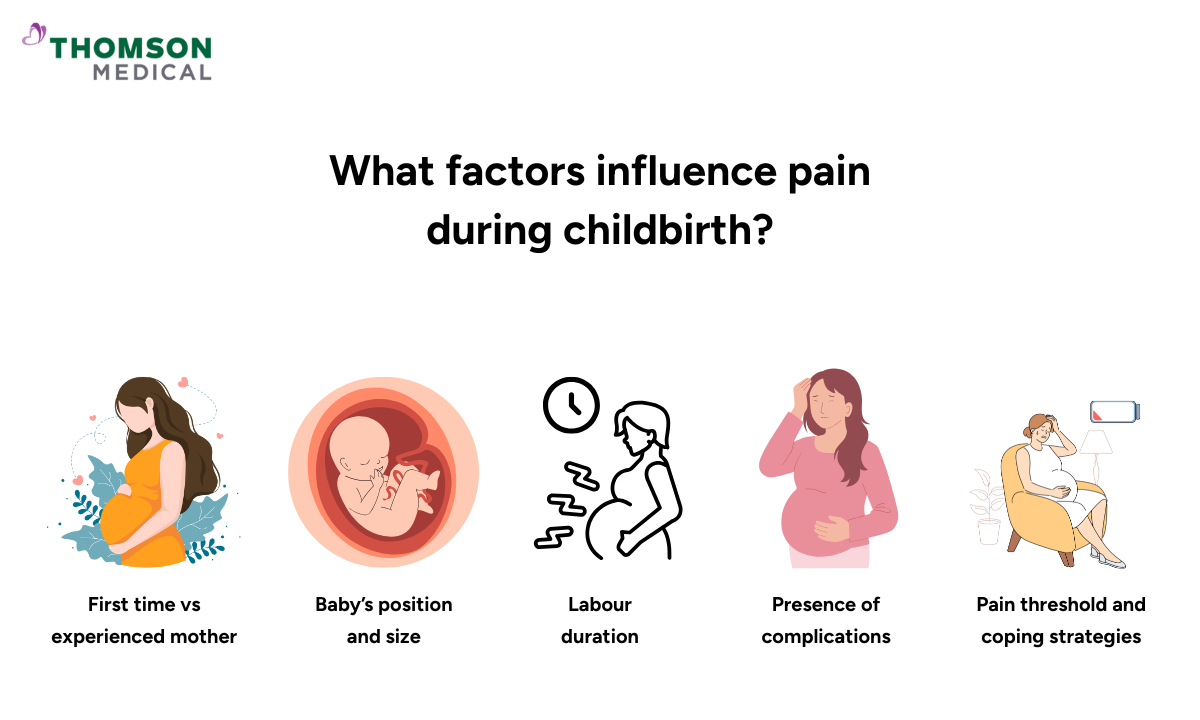When preparing for childbirth, one of the biggest questions many moms-to-be have is whether to opt for a caesarean section or a natural birth. Both methods are safe and widely practised, but they differ in how the baby is delivered, the recovery process, and the type of pain you may experience. Considering these differences early on can help you and your healthcare team create a birth plan that aligns with your needs and ensures the safest outcome for both you and your baby.

What is a C-section?
A caesarean section, or C-section, is a standard surgical procedure for delivering a baby by making an incision in the abdomen and womb. It is frequently planned ahead of time, known as an elective C-section, especially if you’re pregnant with more than one baby, have placenta previa or encounter health issues that put you at risk for vaginal delivery. C-sections are a standard part of modern maternity care and can be lifesaving in some cases, but the decision is generally based on your safety and that of your baby.
While a C-section can be lifesaving and is a common part of modern maternity care, it is still major surgery. Recovery may take longer than after a vaginal birth, and there can be risks such as infection, bleeding, or complications in future pregnancies. Therefore, knowing what to expect from the reasons a C-section might be recommended to what recovery looks like can help you feel more confident and prepared for your birth journey.
Risks of a C-section
A caesarean section is a routine and often lifesaving procedure, but like any major surgery, it does come with some risks. Possible complications include infection, heavy bleeding, blood clots, and reactions to anaesthesia such as a spinal block or epidural. Some women also notice discomfort from scar tissue or worry about possible effects in future pregnancies, like placenta problems. For babies, most are born safely, though a few may experience temporary breathing issues, especially if delivered before labour starts. While these risks can sound worrying, your medical team will take every step to keep both you and your baby safe.
What is a natural birth?
A natural birth, or vaginal delivery, refers to the birth of a baby through the vagina and birth canal without surgical intervention. In most cases, labour begins on its own and progresses naturally, although medical support such as induction of labour, pain relief options, or assisted delivery of a baby with forceps or vacuum may sometimes be needed.
Vaginal birth is the most common method of childbirth all over the world and is considered safe without any complications. Compared to a caesarean delivery, women who have a vaginal birth often recover more quickly, face fewer surgical risks, and can usually begin bonding and breastfeeding their baby sooner.
Possible risks of natural birth
While natural birth is generally safe, it can still carry some risks for both mother and baby. For mothers, possible complications may include perineal tears, heavy bleeding after delivery, infection, or longer-term issues such as pelvic floor weakness and urinary incontinence. For babies, risks may involve temporary birth injuries like bruising or fractures, reduced oxygen supply if labour is prolonged or difficult, and, in certain cases, the need for urgent medical intervention.
What is more painful: C-section or natural birth?
The experience of pain in childbirth varies from woman to woman, but the type of pain differs depending on whether it is a natural birth or a caesarean section.
Aspect | Natural birth | C-section |
Pain during delivery | Intense pain as labour progresses; contractions become stronger and more frequent; pain peaks as the baby passes through the birth canal. | Anaesthesia, which is typically administered as a spinal block or epidural, generally prevents pain during the procedure. |
Pain after delivery | Pain usually eases quickly once the baby is born; recovery discomfort mainly comes from perineal tears, stitches, or soreness. | Significant discomfort after surgery; soreness at the incision site, muscle weakness, and limited mobility. |
Recovery time | Recovery tends to be faster; most women resume basic activities within days. | Recovery is longer; pain and limited movement can last for weeks after birth. |
Overall experience | More painful during labour and delivery, but recovery is quicker. | Less painful during delivery itself, but recovery is longer and often more uncomfortable. |
Don’t know which delivery option might be right for you? Request an appointment with Thomson Medical to discuss your choices with our specialists.
Our O&G specialists
Loading...
What factors influence pain during childbirth?

Every woman’s experience of labour pain is different, and several factors can influence how intense or manageable the pain feels.
First-time vs experienced mothers
For women giving birth for the first time, labour is usually longer and often more painful. The cervix, pelvic floor, and vaginal muscles are not yet used to stretching, so contractions may feel stronger and last longer. Mothers who have previously had a vaginal delivery often experience shorter, smoother labours because their bodies have already adapted to the process, which can make the pain easier to cope with.
Baby’s position and size
The baby’s position and size play a major role in the level of discomfort. A larger baby can put extra pressure on the cervix, pelvic tissues, and birth canal, making contractions more painful. Similarly, if the baby is not in the ideal position, for example, facing upwards (occiput posterior) or in breech, labour may be prolonged and more uncomfortable. On the other hand, when the baby is average in size and in the optimal occiput anterior position, labour is often smoother and less painful.
Length of labour
The duration of labour has a direct effect on pain levels. Prolonged labour can cause exhaustion, dehydration, and stress, which lower the mother’s ability to cope with contractions. In contrast, when labour progresses quickly, the pain may still be strong but is often more tolerable because fatigue does not set in as deeply.
Complications during labour
Certain complications can make labour significantly more painful. Obstructed labour, where the baby cannot move through the birth canal, causes continuous strong contractions without much progress, intensifying discomfort. Other conditions such as preeclampsia, multiple pregnancy, or infections may also increase pain levels. In some cases, assisted delivery or an emergency caesarean section may be necessary to ensure the safety of both mother and baby.
Pain threshold and coping strategies
Every woman has a unique pain threshold. Some can tolerate stronger contractions, while others may find even mild discomfort overwhelming. Coping strategies such as breathing techniques, relaxation methods, and emotional support from partners or healthcare teams can make a big difference. Medical pain relief options, including epidurals, nitrous oxide (gas and air), or opioid medications, are also available to help reduce pain and support a more positive birth experience.
FAQ
Is recovery more painful after a C-section or natural birth?
Recovery tends to be more painful and longer after a caesarean section compared to a normal delivery. Because a C-section is major abdominal surgery, many women experience soreness around the incision site, muscle weakness, and difficulty moving, which can last for several weeks. In contrast, recovery from a vaginal birth usually involves discomfort from perineal tears, stitches, or general soreness, but most mothers are able to walk, move around, and return to light activities within a few days. While labour and delivery may be more painful with a vaginal birth, the recovery is often quicker and less uncomfortable than after a C-section.
Can I choose a C-section to avoid labour pain?
Some women consider a C-section to avoid labour pain, but it is major surgery with its own risks, including infection, blood loss, and longer recovery. While it prevents the pain of contractions, it replaces it with surgical discomfort and possible complications in future pregnancies. For this reason, most doctors recommend C-sections only when medically necessary, not just to avoid labour pain.
How long does pain last after a vaginal birth vs a C-section?
After a vaginal birth, most pain from tears or soreness improves within one to two weeks, though mild discomfort may last a bit longer. After a C-section, incision pain can persist for weeks, with some women feeling tenderness or numbness for months. Recovery usually takes four to six weeks, making vaginal birth recovery quicker overall.
Does a second birth hurt less?
For many women, a second birth can feel less painful and often progresses more quickly than the first. The cervix and pelvic tissues have already stretched once, making dilation and pushing easier. Labour contractions may also be more effective, shortening the process. That said, pain levels vary, and some women still experience significant discomfort, especially if the baby is large, poorly positioned or if complications arise.
Does natural birth always involve tearing?
Natural birth does not always cause tearing, but it is common, particularly for first-time mothers. Perineal tears occur when the tissues around the vaginal opening stretch quickly as the baby’s head passes through. The risk depends on factors such as the baby’s size, position, and speed of delivery, as well as whether an episiotomy is needed. Most tears are minor and heal well, while larger ones may require stitches. Techniques like warm compresses and controlled delivery can help reduce the risk.
How long does it take to recover from a C-section vs natural birth?
Recovery after a vaginal birth is usually quicker. Most women can walk, care for their baby, and resume daily tasks within one to two weeks, though full healing may take up to six weeks. Postpartum recovery from a caesarean section typically takes longer, around six to eight weeks, as the incision and abdominal muscles need time to heal. While both methods allow for good long-term recovery, the first weeks after a C-section are generally more challenging than after a natural birth.
The information provided is intended for general guidance only and should not be considered medical advice. For personalised recommendations and tailored advice, please consult a specialist at Thomson Medical. Request an appointment with Thomson Medical today.
For more information, contact us:
Thomson Specialists (Women's Health)
Thomson Women's Clinic (TWC)
- Novena:
6592 6686 (Call), 8611 8986 (WA) - Bukit Batok:
6569 0668 (Call), 8686 3525 (WA) - Choa Chu Kang:
6893 1227 (Call), 8282 1796 (WA) Jurong:
6262 8588 (Call), 6262 8588 (WA)- Katong (female doctor):
6970 2272 (Call), 8611 9020 (WA) - Punggol:
6243 6843 (Call), 8811 0328 (WA) - Sembawang: 6753 5228
- Sengkang: 6388 8125
- Serangoon (female doctor): 6382 3313
- Tampines: 6857 6266
- Tiong Bahru: 6276 1525
